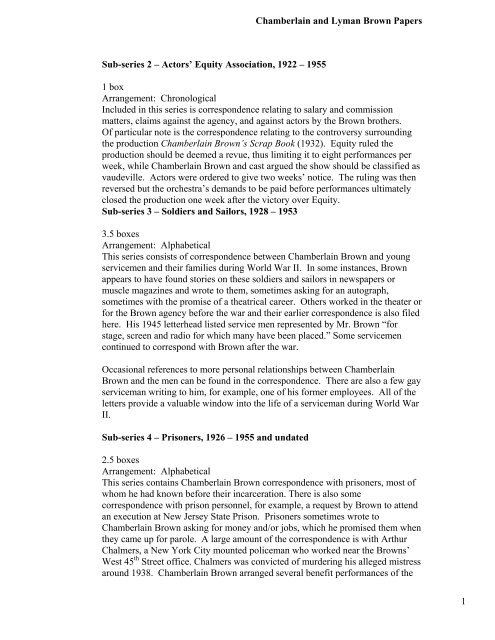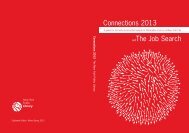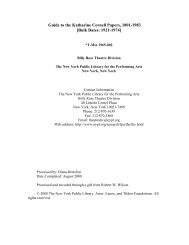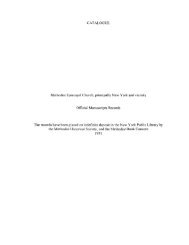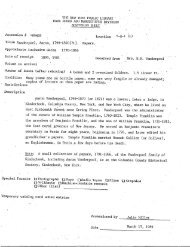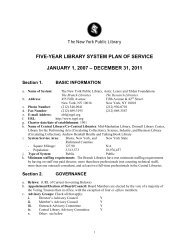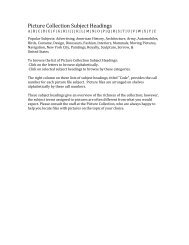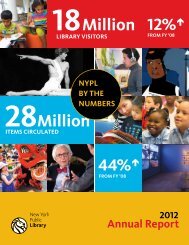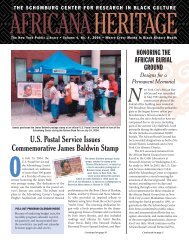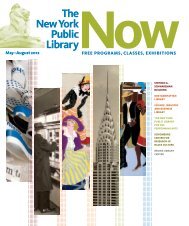View PDF finding aid (590.79 KB) - New York Public Library
View PDF finding aid (590.79 KB) - New York Public Library
View PDF finding aid (590.79 KB) - New York Public Library
Create successful ePaper yourself
Turn your PDF publications into a flip-book with our unique Google optimized e-Paper software.
Chamberlain and Lyman Brown Papers<br />
Sub-series 2 – Actors’ Equity Association, 1922 – 1955<br />
1 box<br />
Arrangement: Chronological<br />
Included in this series is correspondence relating to salary and commission<br />
matters, claims against the agency, and against actors by the Brown brothers.<br />
Of particular note is the correspondence relating to the controversy surrounding<br />
the production Chamberlain Brown’s Scrap Book (1932). Equity ruled the<br />
production should be deemed a revue, thus limiting it to eight performances per<br />
week, while Chamberlain Brown and cast argued the show should be classified as<br />
vaudeville. Actors were ordered to give two weeks’ notice. The ruling was then<br />
reversed but the orchestra’s demands to be p<strong>aid</strong> before performances ultimately<br />
closed the production one week after the victory over Equity.<br />
Sub-series 3 – Soldiers and Sailors, 1928 – 1953<br />
3.5 boxes<br />
Arrangement: Alphabetical<br />
This series consists of correspondence between Chamberlain Brown and young<br />
servicemen and their families during World War II. In some instances, Brown<br />
appears to have found stories on these soldiers and sailors in newspapers or<br />
muscle magazines and wrote to them, sometimes asking for an autograph,<br />
sometimes with the promise of a theatrical career. Others worked in the theater or<br />
for the Brown agency before the war and their earlier correspondence is also filed<br />
here. His 1945 letterhead listed service men represented by Mr. Brown “for<br />
stage, screen and radio for which many have been placed.” Some servicemen<br />
continued to correspond with Brown after the war.<br />
Occasional references to more personal relationships between Chamberlain<br />
Brown and the men can be found in the correspondence. There are also a few gay<br />
serviceman writing to him, for example, one of his former employees. All of the<br />
letters provide a valuable window into the life of a serviceman during World War<br />
II.<br />
Sub-series 4 – Prisoners, 1926 – 1955 and undated<br />
2.5 boxes<br />
Arrangement: Alphabetical<br />
This series contains Chamberlain Brown correspondence with prisoners, most of<br />
whom he had known before their incarceration. There is also some<br />
correspondence with prison personnel, for example, a request by Brown to attend<br />
an execution at <strong>New</strong> Jersey State Prison. Prisoners sometimes wrote to<br />
Chamberlain Brown asking for money and/or jobs, which he promised them when<br />
they came up for parole. A large amount of the correspondence is with Arthur<br />
Chalmers, a <strong>New</strong> <strong>York</strong> City mounted policeman who worked near the Browns’<br />
West 45 th Street office. Chalmers was convicted of murdering his alleged mistress<br />
around 1938. Chamberlain Brown arranged several benefit performances of the<br />
1


